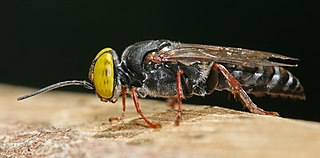
The Crabronidae are a large paraphyletic group of wasps, including nearly all of the species formerly comprising the now-defunct superfamily Sphecoidea. It collectively includes well over 200 genera, containing well over 9000 species. Crabronids were originally a part of the Sphecidae, but the latter name is now restricted to a separate family based on what was once the subfamily Sphecinae. Several of the subfamilies of the Crabronidae are often treated as families in their own right, as is true of the most recent phylogenies.

The Carib grackle is a New World tropical blackbird, a resident breeder in the Lesser Antilles and northern South America east of the Andes, from Colombia east to Venezuela and northeastern Brazil. There are eight subspecies, of which the most widespread is the nominate subspecies of Trinidad and the South American mainland. This subspecies was introduced to Tobago in 1905 and is now common there.

The sombre tit is a member of the tit family found in southeast Europe and southwest Asia. Sombre tits occur in low density in thin woodlands at the elevation range between 1000 and 1600 metres above sea level.
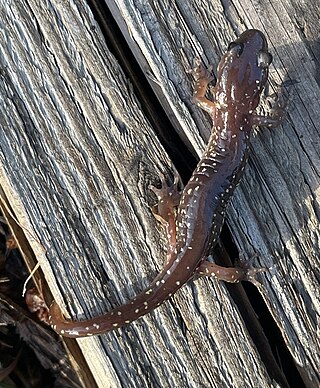
The arboreal salamander is a species of climbing salamander. An insectivore, it is native to California and Baja California, where it is primarily associated with oak and sycamore woodlands, and thick chaparral.

The crested kingfisher is a very large kingfisher that is native to parts of southern Asia, stretching eastwards from the Indian Subcontinent towards Japan. It forms a species complex with the other three Megaceryle species.

Enyo lugubris, the mournful sphinx, is a moth of the family Sphingidae. It is found from Argentina and Paraguay to Uruguay, Venezuela, Guyana, Suriname, French Guiana, Colombia, Ecuador, Peru, Brazil and the West Indies through Belize, Guatemala, Honduras, El Salvador, Nicaragua, Costa Rica and Panama to Mexico and the United States, where it has been recorded from Arizona east to Florida and north to South Carolina. Strays have been recorded from Arkansas, north to Illinois, Michigan and New York.
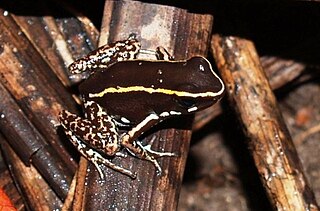
The lovely poison frog or lovely poison-arrow frog is a species of frog in the family Dendrobatidae. It is found on the Caribbean versant of Central America from southeastern Nicaragua through Costa Rica to northwestern Panama, with one record just west of the Panama Canal. Populations from the Pacific versant, formerly included in this species, are now identified as Phyllobates vittatus.

The Senegal lapwing or lesser black-winged lapwing is a species of bird in the family Charadriidae. It is found in the African countries of Angola, Burundi, Cameroon, Republic of the Congo, Democratic Republic of the Congo, Ivory Coast, Eswatini, Gabon, Gambia, Ghana, Guinea, Kenya, Liberia, Malawi, Mali, Mozambique, Nigeria, Rwanda, Senegal, Sierra Leone, Somalia, South Africa, Tanzania, Togo, Uganda, Zambia, and Zimbabwe. It lives primarily in open grassy habitats.
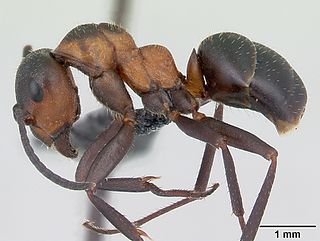
Formica lugubris, also known as the hairy wood ant is commonly found in wooded upland areas across northern Eurasia. Colonies construct large thatched mound nests occupied by thousands of workers, and one or more queens. Workers look similar to other species of wood ants, but Formica lugubris workers can be identified by a fringe of hairs that reaches down to their eyes and prominent hairs between the facets of their compound eyes. Workers can reach sizes of up to 9 mm long; queens are larger, reaching 12 mm long.

Caranx lugubris, the black jack, black trevally, black kingfish, coal fish or black ulua, is a species of large ocean fish in the jack family Carangidae. The species has a circumtropical distribution, found in oceanic, offshore waters of the tropical zones of the Pacific, Atlantic and Indian Oceans. The species is particularly prevalent around offshore islands such as the Caribbean islands in the Atlantic, Hawaii and French Polynesia in the Pacific and the Seychelles and Maldives in the Indian Ocean. Black jack are rare in shallow waters, preferring deep reefs, ledges and seamounts in clear waters. The species is easily distinguished by its black to grey fins and jet black scutes, with the head having a steep profile near the snout. The largest recorded length is 1 m and weight of 17.9 kg. The black jack lives either individually or in small schools, and is known to school with other species. It is a predatory fish, taking a variety of fish, crustaceans and molluscs as prey. Sexual maturity is reached at 34.6 cm in females and 38.2 cm in males, with spawning taking place between February and September in the Caribbean. The early life history of the species is very poorly understood. Black jack are of high importance to many island fisheries, but are rarely encountered in most continental fisheries. The species has a reputation as a gamefish, and is variably considered a terrible or excellent food fish, although several cases of ciguatera poisoning have been attributed to the species. The species was initially named Caranx ascensionis by Georges Cuvier, however several issues with the use of this name have seen Felipe Poey's name Caranx lugubris become the valid scientific name.

Lepidodactylus lugubris, known as the mourning gecko or common smooth-scaled gecko, is a species of lizard, a gecko of the family Gekkonidae.

The square-tailed drongo-cuckoo is a species of cuckoo that resembles a black drongo. It is found along the Himalayas extending east into Southeast Asia. The calls are series of piercing sharp whistles rising in pitch but shrill and choppily delivered. In the past, the species S. lugubris also included the subspecies dicruroides, which is now treated as a separate species, the fork-tailed drongo-cuckoo.

The Abyssinian wheatear, or Abyssinian black wheatear, is a species of bird in the family Muscicapidae, the Old World flycatchers and chats. It is found from Ethiopia to southern Kenya and north-eastern Tanzania.
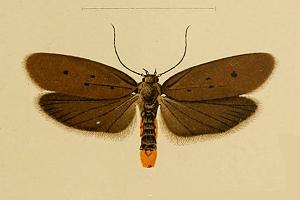
Ethmia lugubris is a moth in the family Depressariidae. It is found in Austria, Bulgaria, Romania and Russia.

Heliobolus lugubris, also known commonly as the bushveld lizard, mourning racerunner, or the black and yellow sand lizard, is a species of lizard in the family Lacertidae. The species is found in Southern Africa: southern Angola, Namibia, Botswana, southwestern Zimbabwe, southern Mozambique, and south-central to northern South Africa.

Pemphredon is a genus of digger wasps in the family Pemphredonidae. The genus is common in the Holarctic, with 12 species represented in Europe. Several species are considered beneficial because of their specialization in aphids.

The Ethiopian cisticola is a species of bird in the family Cisticolidae. It is found in south-central Africa.
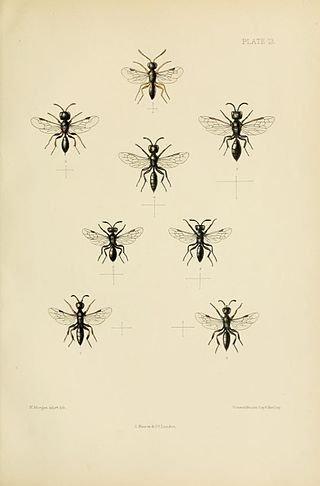
Pemphredon inornata is a species of aphid wasp in the family Pemphredonidae. It is found in Europe and across the Palearctic, North America, and Southern Asia.

Pemphredon lethifer is a Palearctic species of solitary wasp. It prefers to make nests using large twigs from the genus Sambucus.


















